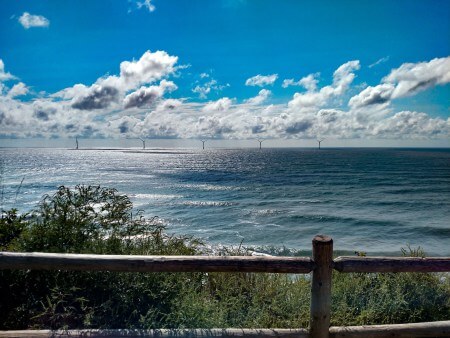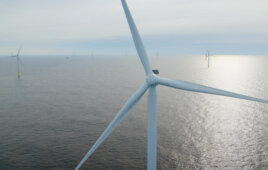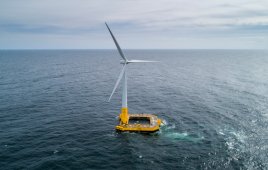Val Stori / Clean Energy Group

Governors from both New York and New Jersey announced commitments to launch the nation’s largest offshore wind solicitations. These commitments confirm the strong business case for offshore wind.
A little over a year ago, U.S. offshore wind (OSW) history was made—thrice. The first U.S. offshore wind farm began spinning off the coast of Rhode Island; BOEM completed its most successful offshore wind lease auction to date, awarding Statoil a wind lease for over $42 million; and New York Governor Cuomo announced a 2400 MW offshore wind goal by 2030 in his State of the State. A little later in the year, two Maryland projects blew away cost expectations, signing contracts to deliver 368 MW of offshore capacity at $0.132/kWh. Contributing to the growing list of major milestones for the U.S. offshore wind sector, last week the Governors from both New York and New Jersey announced commitments to launch the nation’s largest offshore wind solicitations. These commitments confirm the strong business case for offshore wind.
The actions of Governor Andrew Cuomo and Governor Phil Murphy demonstrate how executive leadership and state-level policy can play an essential role in the commercialization of the offshore wind industry. Now, Rhode Island, Connecticut, Massachusetts, New York, and New Jersey each have policies to support and stimulate offshore wind development in the Northeast. New Jersey Governor Murphy’s Executive Order directing the New Jersey Board of Public Utilities (BPU) to implement the 2010 Offshore Wind Economic Development Act (OWEDA) and develop action plans to meet the goal of 3500 MW by 2030 brings the Northeast’s total offshore wind target commitment to 7500 MW by 2030. (New York’s utilities and load-serving entities are required to procure 2,400 MW by 2030, and Massachusetts’ utilities are required to procure 1,600 MW by 2027.)
Creating workforce and economic development opportunities
While the business case for U.S. OSW is clear, the challenges of building a supply chain, achieving significant scale for cost reductions, and expanding port infrastructure remain. The recent announcements from both New York and New Jersey address these challenges. Each Governor expressed his state’s commitment to offshore wind for reduced GHG emissions and other renewable energy attributes, as well as a desire to strengthen workforce development, economic development, and infrastructure. Governor Murphy’s Executive Order directs the BPU to work with the Department of Environmental Protection to create an Offshore Wind Strategic Plan that would focus on achieving scale to harness cost reductions, job creation, supply chain development, business development, and workforce opportunities.
New York’s Offshore Wind Master Plan addresses these challenges by presenting a comprehensive planning process that addresses finance risk, costs, and workforce/infrastructure needs. It includes twenty accompanying studies, one of which focuses on workforce development and another on infrastructure. The studies explore primary industry needs such as component and equipment manufacturing, port infrastructure expansion, and workforce skills in manufacturing, installation, and operations and maintenance (O&M). The Workforce Opportunity study estimates that state’s offshore wind workforce could peak at 5000 jobs in 2028 in manufacturing, installations, and O&M. These jobs would yield $6 billion in in-state expenditure. Similarly, Massachusetts is looking to cultivate jobs in the offshore wind sector and not only has invested in the New Bedford Marine Commerce Terminal, but also has produced a port infrastructure assessment identifying locations that can support construction and operation activities. The Assessment of Ports and Infrastructure study accompanying the NY Master Plan likewise assessed the needs and capacity of the state’s port facilities for all phases of OSW development. The assessment screened 65 port sites and identified three potential areas—all with some level of infrastructure upgrades—with capabilities to support OSW development:
- New York Harbor: potential siting for manufacturing, assembly, and staging
- Hudson River: potential siting for manufacturing
- Long Island: potential siting for O&M
Governor Cuomo announced that the state is committed to investing $15 million to support clean energy workforce development and infrastructure.
8GW by 2030 to build an industry
But what does it take to build an offshore wind industry in the U.S.? In the Northeast, the offshore wind resource potential is huge, estimated at 233 GW. According to the report U.S. Job Creation in Offshore Wind, under an offshore wind pipeline scenario of 8 GW by 2030 from Maine to Maryland, there is a high probability that the U.S. would attract manufacturing of turbine blades, towers, foundations, and array cables. The recent offshore wind announcements by New York, New Jersey, and Connecticut are helping make that scenario a reality; additionally, Maryland approved the construction of 368 MW of OSW capacity in May 2017. Here’s how the planned and potential procurements play out in the Northeast:
For the rest of the article: https://goo.gl/KLCFmE
Filed Under: Construction, Offshore wind





